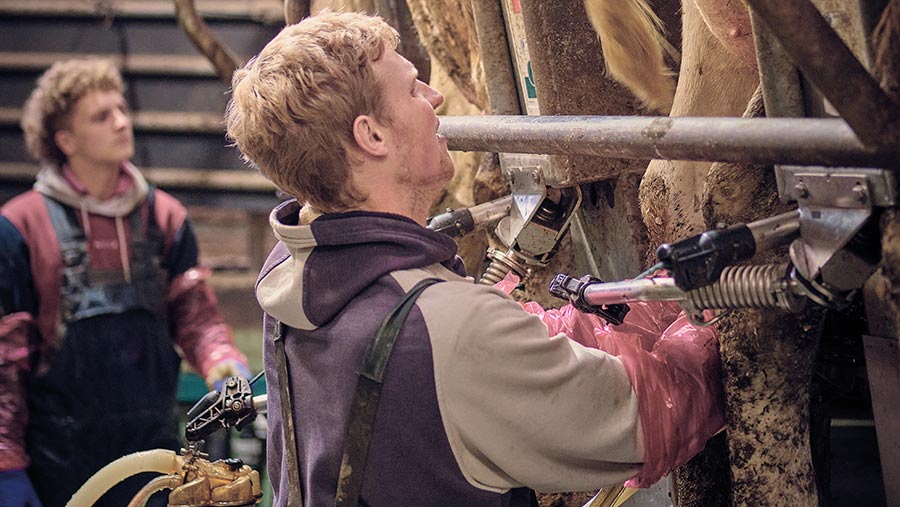What to consider when installing a rotary parlour
 © AHDB
© AHDB There are pros and cons to rotary parlours. Timesaving is one of the main factors in their favour. Less downtime – compared with a herringbone, for example – means it is possible to milk more cows in less time.
A secondary benefit is the potential for a reduced labour requirement, though this varies with the specification of the parlour.
The biggest downside is the cost. As well as the rotary itself, there are often other costs such as a new building or adapting an existing one.
As well as the initial investment, there will be maintenance costs – and the more complex the system, the greater these will be.
See also: New rotary parlour doubles milking throughput
Business ambitions
The first, and arguably most important, consideration is what your longer-term ambitions are for the business.
Rotary parlours are difficult to extend, so it is essential to be clear about the direction of the business.
This will ensure the size and capabilities of the rotary are adequate to meet these ambitions.
Cost
Cost is the next biggest consideration. It is important to be realistic about what you can afford.
Research how much the investment is going to cost and discuss with a consultant whether it is feasible, based on milk contract, cow numbers and yields.
Parlour specifications
As well as the size and manufacture of the rotary parlour, several additional features can be added, for example, an ID system or a feeding system tailored to feeding to yield or flat-rate feeding.
There are also options such as automatic teat spraying and automatic cluster removers.
Financial reasons may dictate these decisions, but it is important to consider how having or not having such equipment will impact on labour requirements.
A vet table/stand is a useful addition. This allows for tasks such as pregnancy diagnosis (PD), vaccination and tail painting during milking, reducing overall cow-handling time.
Building design
Design will vary depending on whether you are building a new site or adapting an existing building.
The key principles are ensuring the design allows for good cow flow and providing easy access for livestock and staff.
Buildings should be light and airy with 2.5-3 spaces available for cows when they enter the rotary and sufficient space to back off and exit at the other end.
Consider electricity and water access, as well as water and waste disposal. There is often an increased usage in rotary systems.
For new-build sheds, planning permission is likely to be needed and can be a lengthy process.
For a grazed herd, locating the shed in the centre of the grazing platform is ideal, but this may not always be possible.
If the rotary is going to accommodate more cows, it is essential to calculate how much more milk is likely to be produced and update or expand the cooling system if needed.
Labour and training
Rotary systems may reduce the labour requirement, but this will depend on the specification and setup of the parlour.
Staff may also require extra training on how to use the parlour. The more complex the system, the greater this input is likely to be.
Case study – Heanton Barton, Devon
Farm facts
- 283ha (700 acres)
- 620 Holstein cows
- Average yield 11,000 litres a cow
- Supplying milk to Crediton Dairy
- Calving all year round

Jim Kirk in front of the rotary parlour © AHDB
A 60-point GEA rotary parlour has slashed milking time to less than two hours at Heanton Barton, Devon.
“We’ve trialled a number of different ways of milking the cows,” explains Jim Kirk, who runs a 620-strong herd of Holstein cows.
“When we came to the farm there was a very old parlour in situ, so we invested in a herringbone. We try to keep all of the staffing within the family but the workload was starting to become a challenge and so we invested in five robots.”
Mr Kirk says that they immediately realised this was not the best option for the farm. As soon as the robots were paid off, they sold them and decided to invest in a rotary parlour.
“That was three-and-a-half years ago, and we have not looked back since.”
The first stage of the investment involved assessing the financial implications of installing a rotary.
“We had a good contract in place and ambitions to expand,” he says.
“I farm alongside my parents, and we saw the rotary as an opportunity to shift the management of the farm – a succession path, as such – so we met with the bank manager, who wanted to know more about our cow numbers, our yields and whether we had the ground to make it work.”
The next step was seeking planning permission and planning the physical installation.
“The parlour and the collecting yard were built into an area of waste ground between two sheds. The build needed a lot of careful planning, taking into consideration factors such as cow flow, access to water and water/waste disposal,” he says.
Since the installation of the parlour, cow numbers have doubled, and milking times are down to less than two hours. The expansion has also resulted in several full-time staff being employed.
If the milk price stays positive, Mr Kirk says the long-term ambition is to increase cow numbers by 100-150 to really maximise the capabilities of the rotary.
He also hopes the simplicity and time-saving nature of the system will help him achieve a better work-life balance. “I am a keen marathon runner, and I would love to get back to that. Hopefully the ease of the system should allow me to take my foot off the pedal slightly in the future.”
